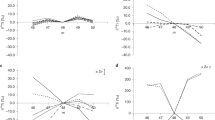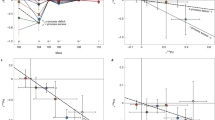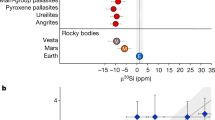Abstract
Meteoritic silicon carbide grains, formed in the winds from carbon stars, contain noble gases and other species whose elemental and isotopic abundances are a probe of stellar nucleosynthesis. Theoretical models of carbon stars can explain a variety of measured abundances, in particular the range of krypton isotope ratios and the excess 22Ne found in the grains.
This is a preview of subscription content, access via your institution
Access options
Subscribe to this journal
Receive 51 print issues and online access
$199.00 per year
only $3.90 per issue
Buy this article
- Purchase on Springer Link
- Instant access to full article PDF
Prices may be subject to local taxes which are calculated during checkout
Similar content being viewed by others
References
Lewis, R., Amari, S. & Anders, E. Nature 348, 293–298 (1990).
Clayton, D. D. Q. Jl R. astr. Soc. 23, 174–212 (1982).
Tang, M. & Anders, E. Geochim. cosmochim. Acta 52, 1235–1244 (1988).
Zinner, E., Tang, M. & Anders, E. Geochim. cosmochim. Acta 53, 3273–3290 (1989).
Ott, U. in Protostars and Planets Vol. 3 (eds Levy, E. H. & Lunine, J. I.) (University of Arizona Press, in the press).
Zinner, E., Tang, M. & Anders, E. Nature 330, 730–732 (1987).
Lambert, D. L. in IAU Colloq. 106, Evolution of Peculiar Red Giant Stars (eds Johnson, H. R. & Zuckerman, B.) 101–130 (Cambridge University Press, 1989).
Gallino, R., Busso, M., Picchio, G., Raiteri, C. M. & Renzini, A. Astrophys. J. 334, L45–L49 (1988).
Käppeler, F., Gallino, R., Busso, M., Picchio, G. & Raiteri, C. M. Astrophys. J. 354, 630–643 (1990).
Iben, I. Jr & Renzini, A. Astrophys. J. 259, L79–L83 (1982).
Iben, I. Jr & Renzini, A. Astrophys. J. 263, L23–L27 (1982).
Hollowell, D. & Iben, I. Jr Astrophys. J. 340, 966–984 (1989).
Busso, M., Gallino, R., Picchio, G. & Raiteri, C. M. Proc. Int. Symp. Nuclear Astrophysics, Nuclei in the Cosmos (eds Oberhummer, H. & Hillebrandt, W.) (Max Planck Institute for Physics and Astrophysics, Garching, in the press).
Lattanzio, J. C. in IAU Colloq. 106, Evolution of Peculiar Red Giant Stars (eds Johnson, H. R. & Zuckerman, B.) 161–175 (Cambridge University Press, 1989).
Ulrich, R. K. in Explosive Nucleosynthesis (eds Schramm, D. N. & Arnett, D. W.) 139–165 (University of Texas Press, Austin, 1973).
Boothroyd, A. I. & Sackmann, I. J. Astrophys. J. 328, 653–670 (1988).
Lattanzio, J. C. Astrophys. J. 311, 708–730 (1986).
Iben, I. Jr Astrophys. J. 260, 821–837 (1982).
Iben, I. Jr in 7 th Adv. Course Swiss Soc. Astr. Astrophys., Advanced Stages in Stellar Evolution (eds Bouvier, P. & Maeder, A.) 3–146 (Geneva Observatory Press, 1977).
Pagel, B. E. J. Proc. Int. Symp. Nuclear Astrophysics Nuclei in the Cosmos (eds Oberhummer, H. & Hillebrandt, W.) (Max Planck Institute for Physics and Astrophysics, Garching, in the press).
Iben, I. Jr & Renzini, A. A. Rev. Astr. Astrophys. 21, 271–342 (1983).
Anders, E. & Grevesse, N. Geochim. cosmochim. Acta 53, 197–214 (1989).
Eberhardt, P., Jungck, M. H. A., Meier, F. O. & Niederer, F. Astrophys. J. 234, L169–L171 (1979).
Lewis, R. S., Alaerts, L., Matsuda, J. & Anders, E. Astrophys. J. 234, L165–L168 (1979).
Clayton, D. D. Nature 332, 683–684 (1988).
Bao, Z. Y. & Käppeler, F. Atom Data nucl. Data Tables 36, 411–451 (1987).
Beer, H. & Macklin, R. L. Astrophys. J. 339, 962–977 (1989).
Holmes, J. A., Woosley, S. E., Fowler, W. A. & Zimmermann, B. A. Atom Data nucl. Data Tables 18, 305–412 (1976).
Harris, M. J. Astrophys. Space Sci. 77, 357–367 (1981).
Lattanzio, J. C. Astrophys. J. 313, L15–L18 (1987).
Ott, U. & Begemann, F. Astrophys. J. 353, L57–L60 (1990).
Gallino, R., Busso, M., Picchio, G. & Raiteri, C. M. in From Miras to Planetary Nebulae (eds Mennessier, M. O. & Omont, A.) 329–331 (Editions Frontières, Paris, 1990).
Ott, U., Begemann, F., Yang, J. & Epstein, S. Nature 332, 700–702 (1988).
Author information
Authors and Affiliations
Rights and permissions
About this article
Cite this article
Gallino, R., Busso, M., Picchio, G. et al. On the astrophysical interpretation of isotope anomalies in meteoritic SiC grains. Nature 348, 298–302 (1990). https://doi.org/10.1038/348298a0
Received:
Accepted:
Issue Date:
DOI: https://doi.org/10.1038/348298a0
This article is cited by
-
Evidence of presolar SiC in the Allende Curious Marie calcium–aluminium-rich inclusion
Nature Astronomy (2020)
-
On laboratory studies of grains from outside the solar system
Journal of Earth System Science (1998)
-
Interstellar grains in meteorites
Nature (1993)
-
Stardust memories
Nature (1992)
-
Thep-nuclei: abundances and origins
The Astronomy and Astrophysics Review (1992)
Comments
By submitting a comment you agree to abide by our Terms and Community Guidelines. If you find something abusive or that does not comply with our terms or guidelines please flag it as inappropriate.



